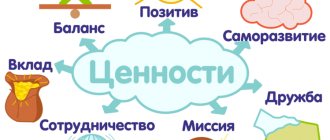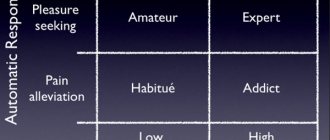Adaptive types, classification
Formed as a result of adaptation to the conditions of the human environment. The food also differed in each region. As a result, distinctive human features appeared.
An adaptive standard is a set of defensive reactions that appear as a result of prolonged exposure to external and internal factors (stressful). Stress factors are the result of the influence of a combination of stimuli.
The norm of biological characteristics and reactions that depend on a person’s environment and manifest themselves in the development of individual characteristics is called the adaptive type of person.
Below are the types of adaptation:
- Biological adaptation is the distinctive features acquired by an organism for the purpose of protection as a result of the action of the environment in which a person was located.
- Ethnic - adaptation of a group of people to climatic and social conditions.
- Social adaptation is adaptation to the people around a person in any environment, to work, etc.
- Psychological - formed and manifested in all types of adaptation in order to survive and develop as a balanced personality.
Adaptive types of humans are classified depending on the environment and as a result of acquired characteristics:
- Continental.
- Tropical.
- Arid.
- Alpine.
- Moderate.
- Arctic.
Adaptive types, their characteristics
All topics in this section:
Main directions and methods of anthropology Anthropology is divided into several directions in two possible ways: traditional and modernized.
Directions of the traditional method Key stages in the formation of humanity. The problem of the ancestral home of modern man There are several theories of the ancestral home of modern man: Historically, the hypothesis of an Asian ancestral home was the first to be comprehensively argued. In Pakistan and India there were
Theories of anthropology An attempt to explain the origin of species was made by Charles Darwin (1809-1882), an English naturalist, creator of the theory of evolution. He is the author of many works: “
Neanderthal culture as a stage of anthropogenesis and sociogenesis Neanderthals lived about 300-24 thousand years ago. They had average height (about 165 cm) and a massive build. The volume of the cranium (1400-1600 cm³ and above) they even surpassed modern
The place of man in the system of the animal world. The main stages of anthropogenesis Place of man - superkingdom - eukaryotes, kingdom - animals, phylum - chordates, subtype - vertebrates, class - mammals, order - primates. The theory of anthropogenesis is based on the simial (from
The lower apes of Tupaia are reminiscent of the first mammals that appeared on earth about 70-60 million years ago. They live in the territory of Hindustan, Indochina, and Malaya. Thanks to the five-rayed limb and good vision
The order of primates, its distinctive features and the place of humans in it. Evolution of human predecessors Order: primates, Suborder: Dry-nosed, Infraorder: Narrow-nosed, Superfamily: Anthropoids, Family: Hominids, Subfamily: Hominins, Genus: People, Species: Homo sapiens, Subspecies: Homo sapiens.
The order of primates, its distinctive features and the place of humans in it Order: primates, Suborder: Dry-nosed, Infraorder: Narrow-nosed, Superfamily: Anthropoids, Family: Hominids, Subfamily: Hominins, Genus: People, Species: Homo sapiens, Subspecies: Homo sapiens.
Man as a primate Man, as a representative of mammals, belongs to the order of primates (higher primates - monkeys and humans, and lower primates - tupaya, lemurs, lorises). The first primates appeared about 70 million years ago.
The problem of the ancestral home of modern man. Key theories of anthropogenesis There are several theories of the ancestral homelands of modern man: Historically, the hypothesis of an Asian ancestral home was the first to be comprehensively argued. Numerous were made in Pakistan and India
Early stages of hominid evolution. The first representatives of the genus Homo in East Africa The family of hominids includes modern man and his immediate predecessors. Usually the oldest boundary of this group is conventionally considered the moment of division of the general evolutionary line into branches
Miocene cooling In the middle and end of the Miocene, as a result of global climate cooling, there was a significant reduction in the area of tropical forests and an increase in the area of savannas. Reduce areas occupied by forests
Labor concept According to the well-known labor concept of F. Engels and its later versions, included in all Soviet textbooks, the emergence of upright walking is closely related to the specialization of the monkey’s hand for
Other hypotheses There are several hypotheses for the origin of the bipedal method of locomotion - bipedia, but, one way or another, it arose as a result of the change from life in trees to terrestrial life. It could have arisen for
Homo erectus. The problem of the ancestral home of Homo sapiens. Theory of polycentrism Where did people of modern appearance come from? In what areas of the Earth did the formation of the modern complex of biological structure and behavior - sapientation - take place? Studying ancient people, I researched
A skillful man. Olduvai culture. Stages of sociogenesis Remains of the so-called. "Olduvai Man" were discovered in the same excavations as the remains of Prezinjanthropus and Zinjanthropus. In its structure it occupies an intermediate position between Homo hab
Evolution of the predecessors of Homo sapiens. The problem of the ancestral home of modern man The family of hominids includes modern man and his immediate predecessors. Usually the oldest boundary of this group is conventionally considered the moment of division of the general evolutionary line into branches
Geographical localization and brief description of the main races The term “race” refers to a system of human populations characterized by similarity in a set of certain hereditary biological characteristics (racial characteristics
The importance of environmental and social environmental factors in the development of polymorphism of Homo sapiens The largest Russian anthropologist V.V. Bunak put forward the theory of “Upper Paleolithic polymorphism,” according to which there were no established racial complexes in the Upper Paleolithic,
Historical and modern distribution of the main human races All people now living on Earth belong to a single biological species of modern man. Scientists gave it the name "homosapiens". Forming a single species, people of different countries differ in
Mechanisms and factors of race formation Raciogenesis is the process of the origin of races. It depends on many factors. Among the most important factors in the formation of races during anthropogenesis is the influence of the geographical environment, in
Morphological description of large races. The main features for differentiation. The classification of races represents a hierarchy of races based on the morphological similarity of the people forming these races, geographical distribution, duration of historical formation.
The concept of races. Monogenism and polygenism The term “race” refers to a system of human populations characterized by similarity in a set of certain hereditary biological characteristics (racial characteristics
The concept of ethnicity. Using data from the anthropology of modern and ancient populations to solve problems of the origin of peoples, an ethnos should be considered any community that develops in a certain territory among people who have real economic ties with each other and speak a mutually intelligible language,
Using data from the anthropology of modern and ancient populations to solve problems of the origin of peoples o The units of research in ethnic anthropology are samples from areal communities of people that differ in anthropological characteristics. This applies to both the modern population (object of
Races and peoples. Main differences in ideas Race is a system of human populations characterized by similarity in a set of certain hereditary biological characteristics. Traits that characterize different races often appear as a result
Western trunk Caucasoids - The natural range of Caucasoids is Europe to the Urals, North Africa, South-West Asia and Hindustan. Includes Nordic, Mediterranean, Falsky, Alpine, East Baltic, Dinars
Eastern trunk The races of the eastern trunk are characterized by two differences: greater evolutionary archaism (in particular, the universal process of dental simplification proceeds more slowly) and increased migration. This
Race and racism. Historiography of the problem Racial differences have been given very different interpretations. In the course of accumulating data on the diversity of humanity, two trends appeared and developed, two approaches to this diversity - monogenism and polygenism
Races of man. Theories of race formation Race is a system of human populations characterized by similarity in a set of certain hereditary biological characteristics. Traits that characterize different races often appear
The role of natural selection in the formation of racial characteristics and adaptive types Natural selection undoubtedly serves as the main active force in the formation of races. The role of selection in the formation of races is evidenced by two groups of phenomena. Firstly, racial characteristics are adapted
Properties of racial characteristics. Characteristics of the Three Main Races It is worth briefly recalling racial characteristics, since this issue always gives rise to considerable confusion. Race is a biological concept and is distinguished purely and only according to biological characteristics.
Adaptive traits in the characteristics of human races Biological traits are very unequal for racial analysis. The classical races of people were distinguished by appearance and, above all, by facial features. However, with the development of research methods
Ethnos. Fundamental characteristics Ethnicity is a group of people united by common characteristics, objective or subjective. Various directions in ethnology include in these characteristics origin, language, culture, territory of residence
Adaptation and acclimatization Acclimatization is the sum of the body’s adaptive-compensatory reactions, as a result of which good general condition is maintained, weight constancy, normal performance, etc.
Human adaptation in various ecological niches of the Earth. Chronology of adaptive types It is easy to notice that in countries with a hot climate, people's skin color is noticeably darker than in countries with a cold climate. Also, closer to the equator, the width of the nose, the thickness of the lips, and the protrusion of the face increase. So
Extreme ecological niches and adaptive types An adaptive type is a reaction norm that arises independently (convergently) under similar environmental conditions, in populations that may not be genetically related.
Growth and development of children in various ecological niches Human physical development, despite the fact that it occurs according to certain biological laws, is under the constant influence of environmental factors, of which the most
Genetic basis of the constitution. Medical aspects of the problem To begin with, let us give several definitions of the term “constitution”. So, this word comes from the Latin constitutio, which means state, addition or property. Often the word constitution
Long-lived. Aging problems; factors influencing life expectancy A long-liver is an ordinary representative of living nature, distinguished by a significant life expectancy compared to the average life expectancy of other representatives of its
Patterns of geographic variability of morphological and physiological characteristics in humans An important property and indicator of racial characteristics is their geographic distribution. As a rule, it is of the nature of clinal variability, that is, quite smooth. For example,
Constitutional schemes of Kretschmer and Sheldon People have always been fascinated by the idea of learning to “read faces”, recognizing the essence of a person by his appearance. Among scientists and the public, from 1790 to the second half of the 19th century, there was a very popular
Morphological and functional aspects of the constitution Morphological aspects of the constitution. For a number of reasons, in biology and medicine, mainly the morphological aspect of the constitution was developed, i.e., it was essentially identified with
Psychological aspects of the constitution. Contribution of Kretschmer and Sheldon The constitution, as a generalized morphofunctional characteristic of an individual, reflects the characteristics of not only physique, but also mental activity, metabolism and vegetative functioning
Psychotypes and somatotypes according to Sheldon. Modern Research Almost everyone who has studied the human constitution has also been interested in the relationship between physique and behavior. Old authors took this relationship for granted and
Characteristics of temperament components and corresponding somatotypes according to W. Sheldon Viscerotonia-endomorphy Somatotonia-mesomorphia Cerebrotonia-ectomorphia Relaxation in posture and movements Confidence
Psychophysiological and psychological aspects of the constitution The study of psychophysiological and psychological parameters characteristic of different constitutional types usually comes down to the study of indicators of the functioning of the central
Sanitary Constitutionology The relationship between constitutional characteristics and health is one of the most important aspects of constitutionalology. The number of works on this topic is large, although the practical application of these research data
Body structure and character According to Kretschmer, He identified the main types of body structure (clearly defined - leptosomal, or psychosomatic, picnic, athletic, and less defined - dysplastic). These types of cons
Ecological aspects of the study of the constitution The driving force behind migration processes that confront humanity with new conditions has always been historical reasons, and adaptation to new ecological niches was carried out not only with the help
Acceleration. Epochal fluctuations in the pace of development ACCELERATION (from the Latin acceleratio - acceleration). The term "was proposed by the German physician Koch in 1935. In anthropology, the acceleration of growth and puberty in children and adolescents compared to
Biological age. Peculiarities of ontogenesis of modern man Biological age is the time elapsed (lived) for a particular organism from the moment of birth. Usually used in contrast to psychological or physiological age
Peripubertal period. Basic morphological and physiological characteristics Peripubertal period and formation of the reproductive system The period of puberty, or peripubertal period from the point of view of the scale of biological changes, is one of the
Growth and development of children and adolescents In early childhood, that is, in the first three years of life, the development of the child’s body and mentality proceeds very quickly and the faster the smaller the child. For example, the growth of a child in the first year of life is
Specificity and periodization of human postnatal ontogenesis In the process of the historical and evolutionary formation of man, his ontogenesis also changed. Major changes in individual development: lengthening of the uterine period, growth will continue
Aging and life expectancy. Main hypotheses MOLECULAR GENETIC THEORIES The hypothesis according to which the cause of aging is changes in the genetic apparatus of the cell is one of the most recognized in modern gerontology
Continental type of adaptability
The population of this zone is characterized by the following characteristics: a flat chest, a tendency to be overweight, and a lower than normal content of substances of mineral origin in the skeleton.
The chest type of body type is common, which is characterized by weak muscle development, stooping, and a hollow in the abdominal area. The abdominal type has also become widespread, the distinctive features of which are: a conical chest, a convex belly, and a regular (wavy) or stooped back.
In the taiga zone, the signs are similar, but the distinguishing feature is the miniature physique.
Tropical type of adaptability
At these latitudes there is high solar activity, tropical storms, etc. The environment plays an important role in the formation of adaptive types of humans.
This type includes people living in warm and humid areas. They differ in the following characteristics: elongated body shape, dolichomorphy - long arms and legs, combined with a short body. Relatively large body surface. There are many sweat glands, which contributes to intense sweat production.
The metabolic rate is average, the synthesis of endogenous fat and cholesterol from the liver is low, which affects human health in these areas. There is a reduced content of minerals in the bones. The phenomenon of low protein is common, and endemic diseases associated with increased or decreased levels of one or another chemical substance in the habitat area have also found their place.
All these signs were acquired due to exposure to a hot climate with high humidity.
Compulsions prevent teen brains from learning adaptive behavior
Matilde M. Vaghi et al. / PNAS, 2020
British researchers have found that a tendency to compulsions (obsessive actions, behavior and rituals) interferes with the formation of adaptive behavior in adolescence. To do this, they conducted an experiment in which participants had to receive rewards using changing information about the probability distribution. The ability to adjust one's decisions so as to obtain the greatest possible gain depended on age and developed as one grew older, but was impaired in compulsive participants. In addition, compulsive behavior also affected the strengthening of neural connections that are normally responsible for the formation of adaptive behavior, scientists write in the Proceedings of the National Academy of Sciences
.
Depending on what information a person is guided by, his behavior can be divided into two different types: habitual and adaptive. In the first case, a person uses already known information and knows in advance the probability of a successful outcome. As an example of the manifestation of habitual behavior, one can cite the path from home to work: a person quickly determines for himself the most optimal route option and subsequently uses it.
The second type of behavior, adaptive, is a little more complicated: in this case, to achieve the goal, the knowledge already acquired is not enough and one has to rely on information available from the outside. An example of such behavior could also be the path from home to work, but complicated, for example, by the fact that an accident occurred on the usual road.
It is believed that adaptive behavior for a person is much more complicated than habitual behavior, and this is in fact true: if habitual behavior is formed quickly enough and is then used, then in the case of adaptive behavior you need to carefully monitor what is happening around you and effectively use incoming information.
Due to its complexity, a stable ability for adaptive behavior appears much later than usual - approximately from early to late adolescence - but it is still not clear what exactly it is regulated by and how exactly it is formed. Researchers led by Matilde Vaghi from University College London decided to study this issue in more detail. They suggested that the capacity for adaptive behavior not only changes with age, but also depends on the expression of compulsive behavior, which is often observed in mental disorders.
To test this, scientists created a small game in which receiving a reward is determined by two probabilities at two different stages. First, the participant is shown two different images of fractals: for each of them, the probability of moving to a particular second stage (blue or red square) is 70 and 30 percent, respectively. Participants do not know the probability in advance, but it remains fixed, so it can be learned over time.
At the second stage (blue or red square), you also need to choose one image from two images, each of which leads to receiving a reward with a certain, but already unspecified probability. Adaptive behavior is thus determined by whether the participant can correctly learn the probability distributions in the first and second steps and then use them to obtain a reward. On the contrary, if the participant focuses only on the reward each time, this will mean that the ability for adaptive behavior is impaired: the reward can be obtained by chance, so it is unreasonable to focus exclusively on it every time.
A total of 569 volunteers aged 18 to 24 took part in the study: each of them was scanned twice, with an interval of at least one and a half years. As predicted, older participants were more likely to use the adaptive strategy (p = 0.023). In addition, over time, participants also focused more on adaptive strategies when solving the task (p = 0.009), and this change was more noticeable at a young age, indicating that adaptive behavior actually develops in early adolescence.
At the same time, the formation of adaptive behavior was influenced by compulsive tendencies: participants who were characterized by frequent compulsions used adaptive strategies less often (p < 0.001) and learned them less effectively over time.
To examine how compulsive behavior affects the brain activity needed to drive adaptive behavior, the researchers conducted a follow-up study using resting-state fMRI of 230 of the same people who participated in the main study. It turned out that compulsive behavior is characterized by a weakened connection between the frontal lobes (main for cognitive functions) and the striatum, which is responsible for the formation of vital forms of behavior (for example, obtaining food) and conditioned reflexes. In the absence of compulsive tendencies, this connection became stronger with age.
Compulsions are considered a disorder of adaptive behavior: due to their obsessive nature, they are not controlled by external factors, so the person prone to them cannot adapt their actions to the environment. As scientists have shown, the tendency to compulsive behavior at an early age can actually disrupt the formation of adaptive behavioral strategies: moreover, this is also reflected in the neural connections that regulate this behavior.
Despite the fact that in the ICD, compulsions are considered a separate symptom, they are most often observed in people with obsessive-compulsive disorder: in it, the desire for obsessive behavior is explained by the appearance of obsessive thoughts (for example, a person with such a disorder may believe that from performing a certain ritual the life and health of him and his loved ones depends). The most effective method of treating obsessive-compulsive disorder is psychotherapy, and its effectiveness was predicted using fMRI two years ago.
Elizaveta Ivtushok
Arid type of adaptability
This type includes people living in desert areas. These latitudes are characterized by rare precipitation and a hot climate.
Features of the physique of an arid adaptive type of person: linear physique, flat chest, poorly developed muscles, small fat component, slow metabolic process in the body. Less sensitive to changes in environmental temperature.
Alpine adaptive type
This type of latitude is characterized by low average annual temperatures and lack of oxygen. People of this type are distinguished by a massive skeleton, a cylindrical chest, and a high content of hemoglobin and red blood cells in the blood. The thyroid gland is less developed. Metabolism is intense compared to the types described above.
The intensity of development is low, as is growth, but life expectancy is significantly higher than in other regions.
Arctic type
The adaptive type of man was formed as a result of the influence of cold and food, mainly of animal origin. The population of this type is distinguished by powerful muscles, a massive skeleton, a fat complex, the chest is large and has the shape of a cylinder.
The hemoglobin level in the Arctic adaptive type of person is high compared to other types. The bone marrow reaches large sizes, the bones are rich in minerals, cholesterol and protein in the blood of such people are at a high level. At the same time, immunity is average.
Impact of climate
An important factor is temperature and its effect on the body. Population densities around the world vary depending on air temperature. Due to thermoregulation of the body, a person adapts to seasonal temperature changes. Therefore, the smaller the difference in seasonal temperature changes, the more favorable the living conditions and the population growth.
Solar activity affects a person’s performance and health; orientation in space also depends on sunlight and increases brain activity. Due to a lack of vitamin D, diseases such as rickets develop.
Adaptive types of humans in different climatic zones differ in skin color and muscles.
Atmospheric pressure also affects physiological parameters. In the north of Eurasia, Canada, and Alaska there is a cold zone. The growing season lasts no more than two months. Low temperatures prevent active farming.
In the latitudes of Eurasia there is a cool zone, as well as in the north and south of America, in the Andes. The warm regions of this belt are distinguished by the development of agriculture.
On the territory of Europe there is a temperate zone, not including the southern islands, the Russian Plain, Kazakhstan, Southern Siberia and the East, Mongolia, Tibet, Northeast China, the southern part of Canada, and the northern regions of the USA.
The warm zone occupies the Eurasian Mediterranean, southern China, most of the USA and Mexico, Chile and Argentina, southern Africa and Australia.
The hot-type belt occupies the predominant area of Africa, South America, South Asia, the Arabian Peninsula, and Central America. Also, agroclimatic zoning of the world is carried out depending on the degree of moisture.
ADAPTIVE AND DEVIANT BEHAVIOR
⇐ PreviousPage 34 of 63Next ⇒
Behavior is a set of specific, currently occurring activities. It can be called adaptive if an expedient, useful result is obtained through it. Achieving such a result becomes possible if the components of the behavior of the activity correspond to the conditions in which this behavior is carried out. Behavior is a multi-level process, ensured and implemented by many different mechanisms, among which the main ones are:
I - mechanisms of the reflection process that determine a person’s orientation in the environment, in specific situations;
II - mechanisms of action of the subject in real, adequate reflected conditions;
III - mechanisms of emotional regulation of behavior at all stages of its development.
The mechanisms of speech mediation and memory function with each of these mechanisms From the point of view of the level organization of behavior, reflection mechanisms appear in the form of processes of perception, sensation of thinking; mechanisms of action - in the form of movements, skills, tactics, programs or strategies; mechanisms of emotional regulation - in the form of direct experiences and feelings.
Various pathological processes (organic lesions of the central nervous system, mental and somatic diseases) disrupt the equilibrium (adaptive) relationship with the environment, characteristic of the normal functioning of the body, and distort a person’s relationship with the outside world through a change in the structure of his behavior (S.A. Belicheva). Behavior is organized at various levels: biochemical, physiological, mental, social. The mental level itself can be divided into three sublevels: psychophysiological, psychological, socio-psychological. Each of these sublevels has its own specific interaction with the outside world: direct interaction with the physical
doi; interaction mediated by the individual and personal characteristics of the subject; interaction mediated by socio-psychological conditions.
Adaptive behavior at the mental level can be broadly defined as a set of self-regulatory processes provided by congenital or acquired psychophysiological and mental mechanisms. The course of these processes is determined by objective (characteristics of the environment) and subjective (individual-personal characteristics of the subject) conditions: these processes underlie the activities that constitute behavior aimed at achieving a useful result that does not contradict the characteristics and/or personal semantic attitudes of the subject, as well as the basis of emotional regulation and experience of performed behavior.
Structure of adaptive behavior
| Levels of Behavior | I | II | III | IV |
| Types of functional systems | Physiological | Psychophysiological | Mental | Systems of social relations |
| Factor systems | Physiological | Psychophysiological | Psychological | Sociocultural |
| The result provided by the work | Ensuring homeostasis in the functioning of various body systems (in particular, the central nervous system) | Detection and formation of properties and qualities of the mental level | Functioning of the psyche as a holistic entity | Functioning in the system of social relations |
| Approach to the Study of Behavioral Disorders | Pathophysiology | Neuropsychology, pathology view | Pathopsychology | Study of deviations in social behavior |
The concept of the structure of adaptive behavior, discussed above, involves taking into account a number of basic principles in the psychological analysis of behavior.
The first principle of the level organization of adaptive* behavior, according to which behavior is implemented at different levels and each level has its own specifics.
The second principle is a multifunctional structure of behavior, according to which the functions of reflection, action, and emotional regulation are implemented at each level.
The third principle is the optimal structure of behavior,
when adaptive behavior is formed taking into account the optimal, most acceptable way for the subject to achieve the final useful result in the existing conditions.
According to these principles, different types of adaptive behavior at each level and within each level will be based on different functional systems and, accordingly, different conditions and factors.
Each case of disruption of functional systems leads to specific behavioral disorders in general. The task of psychological syndrome analysis is to identify the basis, the destruction of which leads to a certain form of behavioral disorder.
Deviant (deviant) behavior is usually called social behavior that does not correspond to the norms established in a given society (Nevsky I.A.). Famous sociologist I.S. Kohn clarifies the definition of deviant behavior, considering it as a system of actions that deviate from the generally accepted or implied norm, be it the norms of mental health, law, culture and morality. In accordance with the concept of adaptive behavior, any deviation leads to adaptation disorders (mental, socio-psychological, environmental).
Deviant behavior is divided into two broad categories. Firstly,
This is behavior that deviates from the norms of mental health, implying the presence of overt or hidden psychopathology (pathological).
Secondly,
this is antisocial behavior that violates some social, cultural and especially legal norms. When such actions are minor, they are called misdemeanors, and when they are serious and punishable by criminal law, they are called crimes. Accordingly, they talk about delinquent (illegal) and criminal (criminal) behavior.
S.A. Belicheva classifies social deviations in deviant behavior as follows:
Social deviations
selfish orientation:
offenses, misdemeanors related to the desire to obtain material, monetary, property benefits (theft, theft, speculation, patronage, fraud, etc.);
aggressive orientation:
actions directed against the individual (insult, hooliganism, beatings, murders, rape);
socially passive type:
the desire to leave an active lifestyle, evade civic responsibilities, unwillingness to solve personal and social problems (avoidance from work, school, vagrancy, alcoholism, drug addiction, substance abuse, suicide).
Thus, antisocial behavior, which differs in both content and target orientation, can manifest itself in various social deviations: from violations of moral norms to delinquency and crime.
Antisocial manifestations are expressed not only in the external behavioral side, but also in the deformation of the internal regulation of behavior: social moral orientations and ideas.
Deviations in the behavior of children and adolescents are understood as those characteristics and their manifestations that not only attract attention, but also alarm educators (parents, teachers, the public). These behavioral features not only indicate deviations from generally accepted norms and requirements, but also carry the beginnings and sources of future offenses, violations of moral, social, legal norms, legal requirements, and represent a potential threat to the subject of behavior, the development of his personality, and the people around him , to society as a whole.
Individual actions are not significant in themselves, but only in connection with what personality characteristics and trends in their development are hidden behind them.
Consequently, by giving the actions and behavior of a child or teenager one or another direction, content, or significance, we thereby exert an arbitrary, purposeful influence on the development of these processes or mechanisms that underlie the moral and other personal properties and qualities of the child. Or, conversely, by preventing certain actions or behavior, we create an obstacle, delay the development of the corresponding properties and qualities of the personality of a child or teenager (Nevsky IL.,
1993).
Thus, the deviant behavior of children and adolescents, on the one hand, can be considered as a symptom, signal, sign of the emergence and development (tendency) of the corresponding personality characteristics, on the other hand, act as a conductor of educational influence on the development of personality, a means of its formation or
purposeful influence on its formation (i.e. educational means).
Considering behavior as a phenomenon that indicates a particular state of the individual, the tendency of its development, we must remember that the same outwardly similar features of behavior can indicate different processes occurring in the individual’s psyche, and vice versa.
Therefore, when qualifying one or another feature of a student’s behavior as a deviation, we must take into account the conditions, stability, frequency of its manifestation, personality traits, character, age of the student and much more. And only after this make one judgment or another, or even more so, determine the measure of influence.
Sometimes a student is literally driven into a Procrustean bed of one or another judgment about him, an assessment of his behavior. His behavior is qualified unambiguously, an appropriate label is attached, and the system of value judgments about him and the nature of his relationships with others are adjusted to this label. A gross pedagogical mistake is being made, fraught with unpleasant consequences.
Or, conversely, characteristics of a student’s behavior that are acceptable or convenient for some reason (helpfulness, uncriticality, attentiveness to the teacher, willingness to act in the expected way, etc.) are regarded by the teacher as positive, encouraged by him, and the student is presented to the class as a social model for imitation. At the same time, the teacher not only does not see, but literally cultivates opportunism, servility, conformism and other negative characteristics in this student.
Manifestations of deviations in the behavior of children and adolescents, their moral and social development can be very different depending on individual characteristics and personal manifestations, specific conditions and circumstances of life and activity. As a rule, they can be reduced into the following groups: situational, temporary
manifestations or reactions caused by factors and circumstances that provoke them, and
stable
forms of behavioral deviations, developing according to one type or another, due to unfavorable conditions of life and activity in general.
Behavioral reactions are caused by unfavorable circumstances or living conditions, acting once or systematically. In the latter case, changes in behavior leading to one or another reaction accumulate and appear gradually or lead to
sudden breakdown. Examples include reactions of refusal, protest, withdrawal, and aggression. There can be many forms of manifestation of these reactions. They always arise in response to one or another psychological situation and disappear when it is eliminated.
But, if situations are often repeated, layered, reactions are consolidated, stable psychological formations (complexes) arise, leading to the development of one or another type of behavior.
This is how active-adaptive or passive-adaptive behavior is formed: destructive-aggressive,
aimed at revolutionary restructuring, changing the activities of the group and one’s own behavior in it;
destructive-compensatory,
when the restructuring of the group’s activities and one’s behavior is accompanied and consolidated by a major concession to its demands.
A special place is occupied by the compensatory-illusory
form of behavior, when the dissatisfaction of needs and aspirations, the persistent psychological discomfort of a teenager find a way out in artificial excitement, intoxication, stupefying oneself with disinhibition of communication, music, dancing, nicotine, alcohol, drugs, toxic and medicinal substances.
In essence, we are talking about compensatory behavior, which is expressed in extreme forms of conformism or nonconformism.
We can distinguish different types of deviant behavior, the form of manifestation of which is various variants of social maladjustment:
Deviant behavior
Maladaptive behavior:
affective, deprived, autistic, suicidal, addictive Based on:
disorders of mental and personal development, mental deprivation, psychological discomfort
Antisocial behavior:
aggressive,
delinquent (illegal),
criminogenic (criminal) Based on:
socialization disorders, socio-pedagogical neglect, deformations in behavior regulation,
social disruption, desocialization
⇐ Previous34Next ⇒
Recommended pages:
Use the site search:
Moderate type of adaptability
There is a relationship between adaptive human types and races, since the formation of different human types determines their distribution throughout the world.
The temperate zone type is the most common on the planet. In terms of distinctive features and climate, it occupies an intermediate position between two types: arctic and tropical.
The moderate type is widespread, combining many different factors of all latitudes to which the body must adapt.
Humans as a species are distinguished by enormous variability in morphological and physiological characteristics. In part, this variability is the response of different populations to their environment. This reaction is adaptive in nature and is the reason for the formation of adaptive types that are independent of race and ethnicity. Under the same conditions, groups of different origins have the same direction of adaptive reactions.
How can you imagine the nature of the adaptive type ? It is unequal to race, since it manifests itself regardless of ethnic group and race in similar conditions of existence. An adaptive type is a reaction norm that emerges convergently under similar environmental conditions in populations that may not be genetically related to each other, while a racial community necessarily presupposes the common origin of all its constituent groups living in a certain territory.
In the tropical zone, we find a similar set of adaptive traits among the Caucasian population of India, Australians and African aborigines. In the Far North, the Sami, Nenets, Chukchi and Eskimos display a single direction of adaptive reactions. The same applies to the indigenous desert inhabitants, who are ethnically and racially diverse. According to the racial diagnostic complex, which characterizes the structure of the face and head, all Russian groups, which include natives not only of the East European Plain, but also the coast of the White Sea and Transbaikalia, show very close similarities to each other and clearly differ from the Buryats of Transbaikalia - representatives of the Mongoloid race . At the same time, in terms of the morphofunctional complex, including characteristics of body size, the level of proteins and lipids in the blood and gas exchange, Russian groups differ from each other, and some groups of Russians show a closer connection with the Buryats than with genetically and territorially close neighbors.
The main racial diagnostic traits of an adaptive nature (skin color, shape of hair and nose, development of the mucous membrane of the lips) were formed at the dawn of human history, in the Upper Paleolithic era. Adaptive types have been formed throughout human history. After all, many areas of the ecumene became inhabited in a relatively recent time in a historical sense, however, adaptive features managed to take shape quite clearly during this time.
The following morphofunctional complexes can be distinguished:
- arctic,
- alpine,
- moderate,
- continental,
- arid,
- tropical.
The tropical adaptive type seems to be the most ancient. The starting point for the formation of this type can be considered the continental zone of the tropical zone, in which temperature and humidity are optimal, and morphological and physiological diversity is expressed to the greatest extent. The arid zone and the tropical rainforest zone should be considered extreme or less suitable for life. It is here that the shortest and tallest tribes are found, bearing some features of specialization.
The spread of humanity around the globe led to the development of new territories and the formation of new adaptive types. Increases in body mass and density, increased metabolism, and changes in associated physiological traits typical of populations at extratropical latitudes are neoplasms associated with later stages of human history.
Adaptive changes in humans and animals are characterized by both similarities and distinctive features. The most important difference between humans is that human adaptation to certain geographical conditions does not represent an ecological specialization that limits the possibilities of existence in other landscape-climatic zones. This specialization is hampered by human economic and cultural activities.
One of the possible directions for studying the interactions of human populations with the environment may be the correlation of the adaptive type as the norm of biological reaction to the environment with the economic and cultural type as the norm of social reaction .
From an examination of the age-related dynamics of traits, it is clear that adaptive traits in body structure are formed in the early stages of ontogenesis, which indicates their hereditary conditionality created by natural selection.
Characteristics of tropical natives:
- elongated body shape with increased relative evaporation surface,
- increased number of sweat glands,
- intense sweating,
- decreased metabolic rate,
- decrease in muscle mass,
- reduction of endogenous fat synthesis,
- decrease in ATP concentration.
Morphofunctional features of high-mountain populations:
- large chest combined with high vital capacity of the lungs,
- increased blood oxygen saturation,
- general increase in basal metabolism,
- increase in body length and weight.
Arid type:
- facilitating heat transfer processes,
- decreased metabolic activity,
- increase in specific surface area of evaporation.
Arctic type:
- greater body density, development of musculoskeletal mass, strong skeleton,
- high gamma-globulin fraction of blood serum, increased immune properties of the body,
- cylindrical chest shape, almost complete absence of asthenic body type,
- high ventilation capacity of the lungs, increased hemoglobin content in the blood, greater space occupied by the bone marrow, high content of proteins and lipids in the blood serum,
- increased ability to oxidize fats, enhanced energy processes, high stability of metabolism in conditions of hypothermia.
The population of the temperate zone occupies an intermediate position between the tropical and arctic types.










